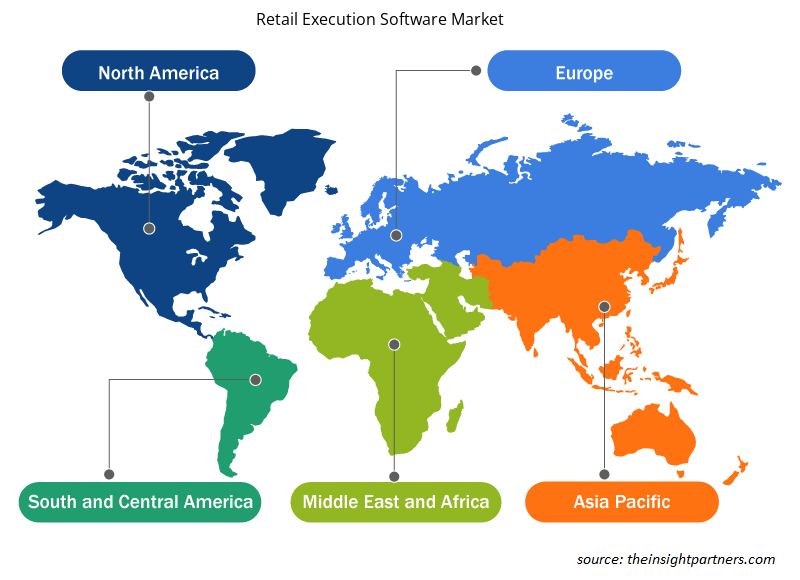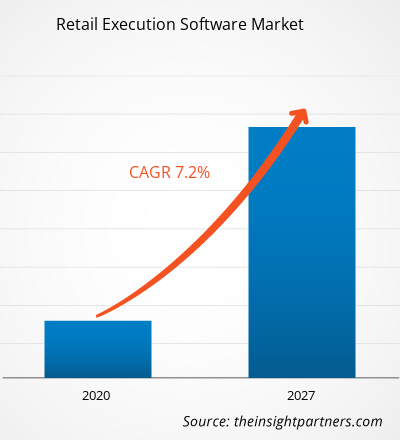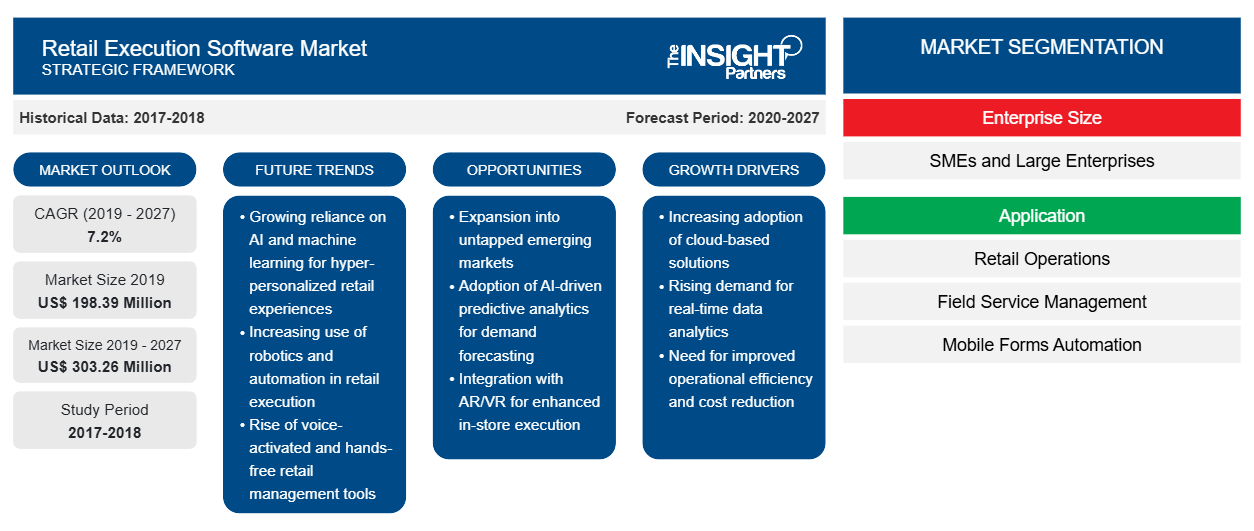El mercado de software de ejecución minorista se valoró en US$ 198,39 millones en 2019 y se proyecta que alcance los US$ 303,26 millones en 2027; se espera que crezca a una CAGR del 7,2% entre 2020 y 2027.
El mercado global de software de ejecución minorista está experimentando un crecimiento sustancial debido a la creciente preferencia por las plataformas minoristas y de comercio electrónico y la creciente integración de las pasarelas de pago con el software de ejecución minorista. Según la geografía, América del Norte lideró el mercado con una participación de ingresos del 31,13 %, seguida de Europa y APAC. La presencia de una economía de rápido crecimiento, la creciente adopción de tecnología automatizada, la creciente penetración de Internet y la enorme adopción de software por parte de los usuarios finales se encuentran entre los principales factores que se espera que impulsen el crecimiento del mercado de software de ejecución minorista en estas regiones. Se prevé que el mercado de software de ejecución minorista en APAC crezca a la CAGR más alta durante el período de pronóstico. La creciente adopción de tecnologías avanzadas en la industria minorista impulsa la tasa de adopción de software de ejecución minorista. Las empresas invierten en software para optimizar sus operaciones comerciales. En APAC, los mercados de más rápido crecimiento para el comercio minorista y el comercio electrónico son India y China. Los consumidores de estos países están muy inclinados hacia las compras en línea debido a la creciente penetración de Internet, y las tendencias de compras en línea están transformando varias áreas del comercio minorista y el comercio electrónico en la región. Por lo tanto, estos factores están impulsando el crecimiento del mercado de software de ejecución minorista en APAC. También se proyecta que otras regiones en desarrollo, como Oriente Medio y África y el Sudeste Asiático, crecerán a un ritmo constante debido a las crecientes iniciativas gubernamentales para digitalizar la economía con la adopción de tecnologías avanzadas.
Personalice este informe según sus necesidades
Obtendrá personalización en cualquier informe, sin cargo, incluidas partes de este informe o análisis a nivel de país, paquete de datos de Excel, así como también grandes ofertas y descuentos para empresas emergentes y universidades.
-
Obtenga las principales tendencias clave del mercado de este informe.Esta muestra GRATUITA incluirá análisis de datos, desde tendencias del mercado hasta estimaciones y pronósticos.
Impacto de la pandemia de COVID-19 en el mercado de software de ejecución minorista
Según el último informe de la Organización Mundial de la Salud (OMS), Estados Unidos, España, Italia, Francia, Alemania, el Reino Unido, Rusia, Turquía, Brasil, Irán y China se encuentran entre los países más afectados por el brote de COVID-19. La crisis está afectando negativamente a las industrias de todo el mundo. La economía mundial fue la más afectada en 2020 y es probable que continúe también en 2021. El brote ha creado importantes perturbaciones en industrias primarias como la logística, el comercio minorista y el comercio electrónico. La fuerte caída de la industria de los negocios de logística internacional está frenando el crecimiento del mercado mundial de software de ejecución minorista.
Perspectivas del mercado de software de ejecución minorista
Mayor integración de las pasarelas de pago con el software de ejecución minorista
Impulsa el crecimiento del mercado de software de ejecución minorista
Los pagos en línea son relativamente populares en la región APAC, ya que la mayoría de los consumidores utilizan dispositivos móviles para pagar sus productos. En países como Corea del Sur, Japón, Singapur y Australia, se utilizan varias opciones populares de pago electrónico para las compras digitales a través de dispositivos móviles. Las empresas de pasarelas de pago de estos países están ofreciendo soluciones integrales de pago electrónico a varios proveedores de software de ejecución minorista para aprovechar la ola del desarrollo tecnológico. Además, el crecimiento del mercado se atribuye a los avances en la tecnología de pasarelas de pago y al aumento del uso de billeteras móviles. Se espera que la creciente integración de los sistemas de pasarelas de pago con el software de ejecución minorista y el aumento de las compras en línea, junto con los avances en los métodos de facturación, impulsen aún más la demanda de software de ejecución minorista durante el período de pronóstico.
Perspectivas del mercado basadas en el tamaño de las empresas
Según el tamaño de la empresa, el mercado de software de ejecución minorista se divide en grandes empresas y pymes. En 2019, el segmento de grandes empresas representó una participación significativa en el mercado. Sin embargo, se prevé que el segmento de pymes registre una CAGR significativa durante el período de pronóstico.
Perspectivas de mercado basadas en aplicaciones
Según la aplicación, el mercado de software de ejecución minorista se segmenta en operaciones minoristas, gestión de servicios de campo, automatización de formularios móviles, ventas de campo, gestión de promociones comerciales, compromiso de los empleados y otros. En 2019, el segmento de operaciones minoristas representó una participación significativa en el mercado. Las operaciones minoristas involucran la gestión de personas, cadena de suministro, diseño de tiendas, operaciones de efectivo, inventario físico y gestión de datos maestros, promociones y precios. El software de ejecución minorista para operaciones minoristas equipa a las tiendas minoristas físicas con herramientas para aprovechar su información actual y aprovecharla de una manera que beneficie a su negocio.
Las empresas están muy comprometidas con el desarrollo de nuevos productos para ganar terreno en el mercado de software de ejecución minorista. Por ejemplo, Salesforce lanzó un nuevo producto industrial, Consumer Goods Cloud, que permite a las empresas de bienes de consumo impulsar el crecimiento de los ingresos y aumentar el ROI mediante capacidades mejoradas de ejecución minorista. A continuación, se enumeran algunos desarrollos de los actores clave:ROI through enhanced retail execution capabilities. A few developments by key players are listed below:
2020: StayinFront, Inc., la solución de análisis de datos minoristas (RDI) amplió su asociación con Field Sales Solutions para realizar análisis en tiempo real. La vista de campo y la vista de ROI de StayinFront RDI brindan información útil para los equipos de ventas de campo. Los servicios facilitan y maximizan la efectividad en la tienda, lo que permite a los clientes de Field Sales Solutions hacer más, saber más y vender más.
2018: Intelligence Retail se acercó a IBM para mejorar su oferta principal y permitir que sus clientes aprovechen el seguimiento de los indicadores clave de auditoría de la tienda en tiempo real. Un nuevo módulo analítico de la solución Intelligence Retail, basado en las tecnologías integradas de IBM Watson Analytics, está diseñado para ayudar a realizar un seguimiento eficaz de los indicadores clave de la auditoría minorista mediante el procesamiento en tiempo real de big data, incluida la disponibilidad de productos en el estante, la participación en el estante, los precios y las promociones.
Perspectivas regionales del mercado de software de ejecución minorista
Los analistas de Insight Partners explicaron en detalle las tendencias y los factores regionales que influyen en el mercado de software de ejecución minorista durante el período de pronóstico. Esta sección también analiza los segmentos y la geografía del mercado de software de ejecución minorista en América del Norte, Europa, Asia Pacífico, Oriente Medio y África, y América del Sur y Central.

- Obtenga datos regionales específicos para el mercado de software de ejecución minorista
Alcance del informe de mercado de software de ejecución minorista
| Atributo del informe | Detalles |
|---|---|
| Tamaño del mercado en 2019 | US$ 198,39 millones |
| Tamaño del mercado en 2027 | US$ 303,26 millones |
| CAGR global (2019-2027) | 7,2% |
| Datos históricos | 2017-2018 |
| Período de pronóstico | 2020-2027 |
| Segmentos cubiertos |
Por tamaño de empresa
|
| Regiones y países cubiertos |
América del norte
|
| Líderes del mercado y perfiles de empresas clave |
|
Densidad de actores del mercado de software de ejecución minorista: comprensión de su impacto en la dinámica empresarial
El mercado de software de ejecución minorista está creciendo rápidamente, impulsado por la creciente demanda de los usuarios finales debido a factores como la evolución de las preferencias de los consumidores, los avances tecnológicos y una mayor conciencia de los beneficios del producto. A medida que aumenta la demanda, las empresas amplían sus ofertas, innovan para satisfacer las necesidades de los consumidores y aprovechan las tendencias emergentes, lo que impulsa aún más el crecimiento del mercado.
La densidad de actores del mercado se refiere a la distribución de las empresas o firmas que operan dentro de un mercado o industria en particular. Indica cuántos competidores (actores del mercado) están presentes en un espacio de mercado determinado en relación con su tamaño o valor total de mercado.
Las principales empresas que operan en el mercado de software de ejecución minorista son:
- Bizom (Mobisy Technologies Private Limited)
- EdgeCG (StayinFront, Inc.),
- Inteligencia minorista
- Mobisoft
- Sonda POP
Descargo de responsabilidad : Las empresas enumeradas anteriormente no están clasificadas en ningún orden particular.

- Obtenga una descripción general de los principales actores clave del mercado de software de ejecución minorista
Por tamaño de empresa
- Grandes empresas
- PYMES
Por aplicación
- Operaciones minoristas
- Gestión de servicios de campo
- Automatización de formularios móviles
- Ventas de campo
- Gestión de la promoción comercial
- Compromiso de los empleados
- Otros
Por geografía
-
América del norte
- A NOSOTROS
- Canadá
- México
-
Europa
- Francia
- Alemania
- Italia
- Reino Unido
- Rusia
- Resto de Europa
-
Asia Pacífico (APAC)
- Porcelana
- India
- Corea del Sur
- Japón
- Australia
- Resto de APAC
-
Oriente Medio y África (MEA)
- Sudáfrica
- Arabia Saudita
- Emiratos Árabes Unidos
- Resto de MEA
-
América del Sur (SAM)
- Brasil
- Argentina
- Resto de SAM
Perfiles de empresas
- Bizom (Mobisy Technologies Private Limited)
- EdgeCG (StayinFront, Inc.)
- Inteligencia minorista
- Mobisoft
- Sonda POP
- Soluciones móviles de primavera, Inc.
- Soluciones tecnológicas Trax Pte Ltd.
- Valomnia
- Ganar
- Grupo Kantar
- Análisis histórico (2 años), año base, pronóstico (7 años) con CAGR
- Análisis PEST y FODA
- Tamaño del mercado, valor/volumen: global, regional y nacional
- Industria y panorama competitivo
- Conjunto de datos de Excel
Informes recientes
Informes relacionados
Testimonios
Razón para comprar
- Toma de decisiones informada
- Comprensión de la dinámica del mercado
- Análisis competitivo
- Información sobre clientes
- Pronósticos del mercado
- Mitigación de riesgos
- Planificación estratégica
- Justificación de la inversión
- Identificación de mercados emergentes
- Mejora de las estrategias de marketing
- Impulso de la eficiencia operativa
- Alineación con las tendencias regulatorias























 Obtenga una muestra gratuita para - Mercado de software de ejecución minorista
Obtenga una muestra gratuita para - Mercado de software de ejecución minorista